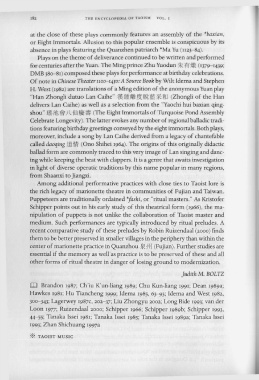Page 222 - The Encyclopedia of Taoism v1_A-L
P. 222
182 TH E EN CYC LOPEDIA OF TA O IS M VOL . 1
at the close of these plays commonly features an assembly of the *baxian,
or Eight Immortals. Allusion to thi popular ensemble is conspicuous by its
absence in plays featuring the Quanzhen patriarch *Ma Yu (1123- 84).
Plays on the theme of deliverance continued to be written and performed
for centuries after the Yuan. The Ming prince Zhu Yuodun *= f-J:trl (1379- 1439;
DMB 380- 81) composed these plays for performance at birthday celebrations.
Of note in Chinese Theater 110(f-1450: A Source Book by Wilt Idema and Stephen
H. West (1982) are translations of a Ming edition of the anonymous Yuan play
"Han Zhongli dutuo Lan Caihe" ~~liJJI£JJtijftm:71UQ (Zhongli of the Han
delivers Lan Caihe) as well as a selection from the "Yaochi hui baxian qing-
shou" fit Ytl!. wr ) {w m _ (The Eight Immortals of Turquoise Pond Assembly
Celebrate Longevity). The latter evokes any number of regional balladic tradi-
tions featuring birthday greetings conveyed by the eight immortals. Both plays,
moreover, include a song by Lan Caihe derived from a legacy of chantefable
called daoqing i!! tw (Ono Shihei 1964). The origins of this originally didactic
ballad form are commonly traced to this very image of Lan singing and danc-
ing while keeping the beat with clappers. It is a genre that awaits investigation
in light of diverse operatic traditions by this name popular in many regions,
from Shaanxi to Jiangxi.
Among additional performative practices with close ties to Taoist lore is
the rich legacy of marionette theatre in communities of Fujian and Taiwan.
Puppeteers are traditionally ordained *fashi, or "ritual masters." As Kristofer
Schipper points out in his early study of this theatrical form (1966), the ma-
nipulation of puppets is not unlike the collaboration of Taoist master and
medium. Such performances are typically introduced by ritual preludes. A
recent comparative study of these preludes by Robin Ruizendaal (2000) finds
them to be better preserved in smaller villages in the periphery than within the
center of marionette practice in Quanzhou jJHI'1 (Fujian). Further studies are
essential if the memory as well as practice is to be preserved of these and all
other forms of ritual theatre in danger of losing ground to modernization.
Judith M. BOLTZ
m Brandon 1987; Ch'iu Kun-liang 1989; Chu Kun-liang 1991; Dean 1989a;
Hawkes 1981; Hu Tiancheng 1999; Idema 1985, 63-93; Idema and West 1982,
30(f-343; Lagerwey 1987C, 202-37; Liu Zhongyu 2002; Long Bide 1993; van der
Loon 1977; Ruizendaal 2000; Schipper 1966; Schipper 1989b; Schipper 1993,
44- 55; Tanaka Issei 1981; Tanaka Issei 1985; Tanaka Issei 1989a; Tanaka Issei
1993; Zhan Shichuang 1997a
* TAOIST MUSIC

